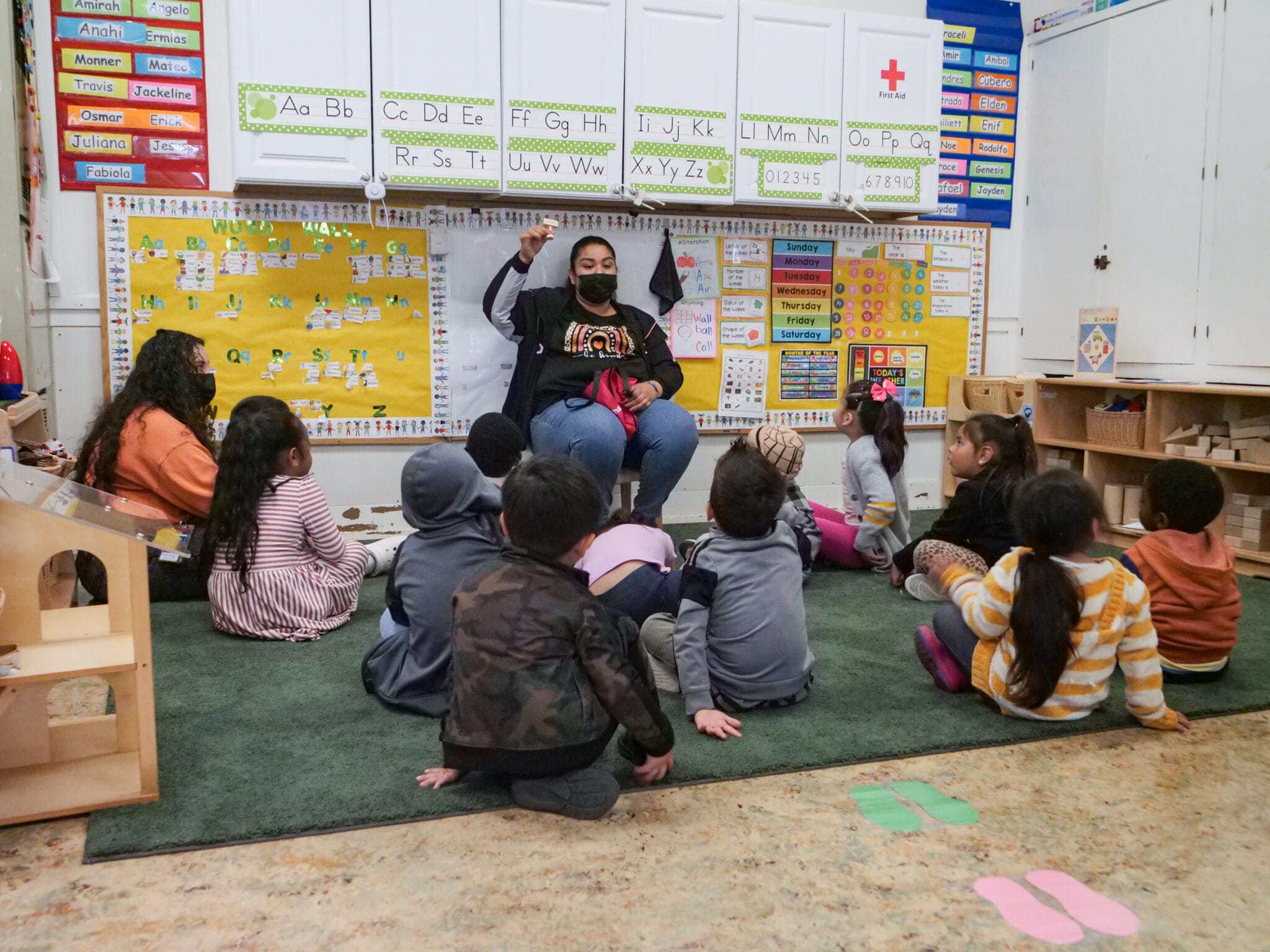Transitional kindergarten (TK) is growing into a universal early learning option for four-year-olds in California. During the 2022-2023 year, districts began adding new classrooms and new teachers in the first wave of expansion. The Center for the Study of Child Care Employment (CSCCE) is interested in how TK teachers view the changes occurring around them. Their perspectives, gathered through our 2023 California Early Care and Education Workforce Study, provide insight into how TK expansion is playing out in schools throughout the state.
Changes to School Resources and Staffing
Developing a new grade level is a massive undertaking, and finding teachers to fill these new positions is an important step. Other new requirements for districts are also part of the package: preparing rooms for younger (and smaller) children; purchasing equipment; selecting a curriculum suitable for four-year-olds; and increasing support staff in the central office.
In Spring 2023, our survey reached nearly 400 TK teachers. Some teachers had been in TK since it began as a pilot program around 10 years ago; others were newer to teaching four-year-olds. What kind of changes did they observe in their school during the 2022-2023 school year? The chart below shows their responses.
“Other” responses in the chart above allowed for write-in responses. Most often, teachers who selected this option described gaining an assistant or aide or having their previous aide’s hours extended. A few mentioned new classrooms opening or switching from a TK/kindergarten combination classroom to TK only.
In addition to the multiple choice question shown above, we asked teachers about the staffing in their programs. In the 2022-2023 school year, districts faced a new requirement to have a 12:1 student-to-teacher ratio. This ratio may further decrease to 10:1 in the future. Districts have a choice in how to allocate their staff and usually hire a paraprofessional or teaching assistant to fill the second position in each classroom. By law, this ratio must be in effect for 100 percent of instructional time, but do districts define “instructional time” in the same way?
According to our survey responses, 10 percent of TK teachers reported having no assistant or aide at all. Some of these teachers have small class sizes (12 students or less), so they may not need an aide to stay within the required ratio. Looking at classes where an assistant is likely required (13 to 24 students), we still find that 9 percent of full-day teachers reported not working with an aide or assistant. Some of these educators may maintain the ratio some other way—for instance, with a co-teacher—but our data suggest that some schools struggled to hire assistant teachers.
Among TK teachers who reported working with an aide, the majority of respondents (75 percent) were accompanied for the “full duration of their session.” This finding suggests districts mostly hire for the full program day and/or it is easier to staff positions that align with program hours.
Takeaways
Four major themes emerge from this survey data: curriculum; developmentally appropriate practice; teaching teams; and enrollment.
Curriculum
The first year of TK expansion saw a variety of shifts and new resources in schools as they continue working toward universal eligibility in Fall 2025. In our chart above, materials and curriculum were the most likely to be updated this past year, but by less than one half of schools. By statute, districts must ultimately align their curricula with the state’s early learning guidelines, Preschool Learning Foundations (PLF), but specific curriculum is a local decision. The PLF are currently being updated “to incorporate recent research in the field, including best practices to support dual language learners, reduce racial bias, and better support the inclusion of children with disabilities.”
The California Department of Education reported in January 2023 that 30 percent of districts were “using curricula that do not reflect the research on effective and developmentally appropriate Pre-K curriculum or are not aligned to the PLF.” Additionally, a similar share of school district leaders felt that they needed more guidance on how to adhere to the PLF. In the meantime, leaders were not able to wait for new PLF guidelines before selecting a curriculum for this past school year (or the coming school year, for that matter). In a recent focus group that we conducted with TK teachers, one participant commented, “Teachers were left to create things on their own. We just adopted a curriculum this spring. So for the fall in 2023, we will have something that will be consistent at all the sites.” Further research will be vital to revealing whether curricula in use adhere to the PLF once they are updated.
Developmentally Appropriate Practice
We surveyed TK teachers about developmentally appropriate practice (DAP) in both 2020 and 2023. At the start of the 2020-2021 school year, around one half of teachers (54 percent) felt their district understood DAP, but only 40 percent agreed that their school community did. In our 2023 survey, 20 percent of the new sample observed an increase in understanding of DAP at their district and a similar share at their school. Such shifts in awareness of developmentally appropriate practice are a crucial development for building a thriving TK program. Our results suggest this change is happening, but in some cases, slowly. In our recent focus group, one teacher said, “Those of us who've been teaching TK for a long time have a good grip of what these students in particular need. But then there's a lot of teachers who don't understand, and they do throw us in trainings. I just feel like it's very overwhelming for those who are new to this grade level.”
Understandably, districts and school leaders have a lot to learn and build with TK. In the long run, centering teaching practices designed for four-year-olds will be the north star of every successful TK program, but districts may struggle to prioritize teaching developmentally appropriate practice as they work furiously to deliver sufficient staffing and resources to get started. In addition to releasing the Preschool Learning Foundations, California should prioritize an information campaign focused on school/district leaders to ensure they have a shared understanding of DAP. Ideally, districts would elevate leaders in the central office with expertise in early care and education (ECE). Additionally, districts should empower teachers who have experience with DAP to act as experts among their peers.
Teaching Teams
Teaching teams were a new requirement for TK in 2022-2023, but hiring practices have been uneven around the state. In our survey, a few teachers wrote short comments about their aides. One teacher explained, “Our aides were laid off, and the position was eliminated in 2020. This year, the positions were added back, and new aides were hired.” Another celebrated, “I was given assistant instructors to stay compliant with 12:1 ratios this year. This has never [before] happened in my career.” A third clarified that her district had “difficulty filling aide positions. Mine wasn't hired until March.” These findings tell us that there is a lot of variation in hiring and building teaching teams, a rocky process that will continue as more classrooms open
Going into year two of TK expansion, California should monitor how classrooms are being staffed—and by whom. Can state leaders identify successful models and help spread them to other schools? Research on the formation of these teams and successful staffing patterns would benefit all districts.
Enrollment Shifts
While some TK teachers (26 percent) reported an increase in class size, a similar share (22 percent) reported a decrease. This apparent contradiction may be driven by a mismatch in hiring additional staff and filling enrollments at the school level. For instance, some districts may be struggling to hire enough TK teachers, though more students have enrolled. By the same token, other districts may have hired more staff in anticipation of expanding the student body only to find a trickle of new students. California policymakers should continue to support districts and monitor fluctuations in staffing and enrollment, since growing pains are likely to continue. A timely staffing study, however, would likely require external funding.
At the local level, districts may want to explore how their enrollment shifts fit within broader patterns in the mixed-delivery ECE system. Each county has a Mixed Delivery Planning Grant and a Local Planning Council. Districts should maximize their participation in both, to better support a holistic understanding of staffing and enrollment patterns locally.
In conclusion: Transitional kindergarten implementation comes with many moving parts. We anticipate that TK teachers will continue to see their classrooms evolve in the 2023-2024 school year. Over time, some of these bumps may smooth out--for instance, the pace of hiring assistants may pick up over time. Additionally, by the end of expansion in Spring 2026, many TK teachers may have the new PK-3 ECE Specialist Instruction Credential. Throughout this process, however, we must continue listening to the teachers themselves to understand how universal TK is coming to life.



